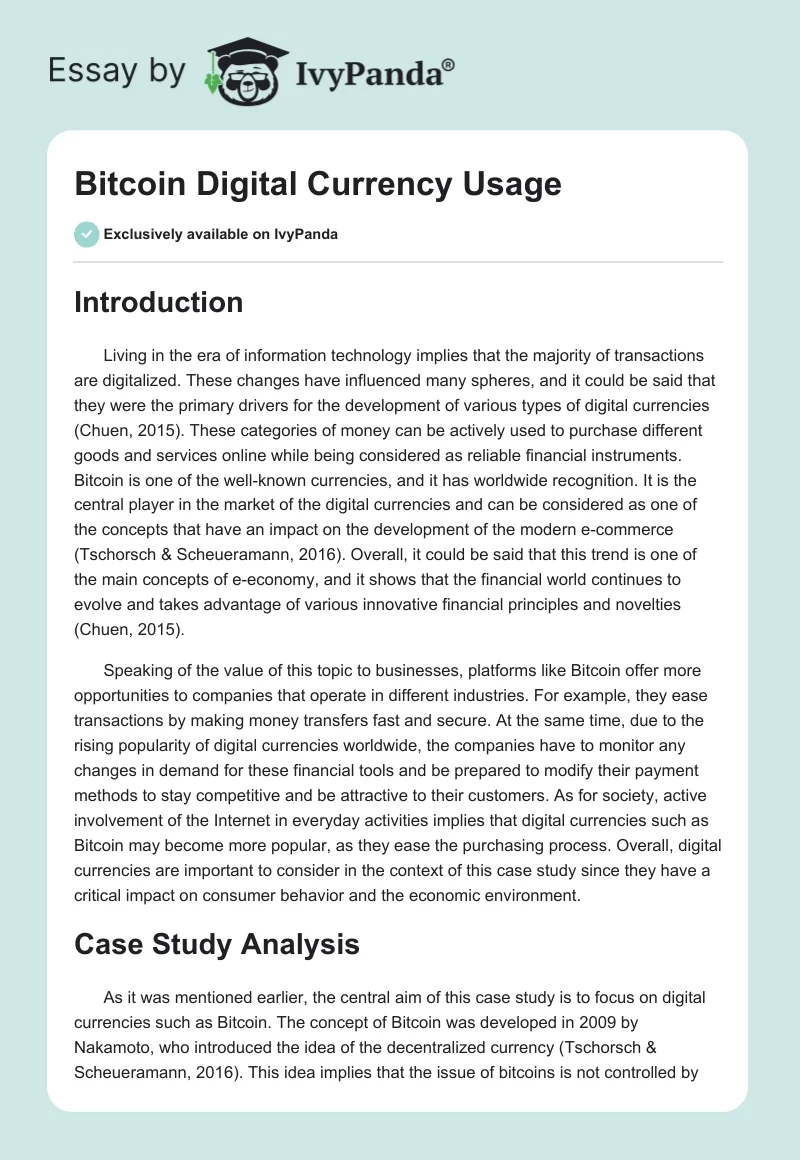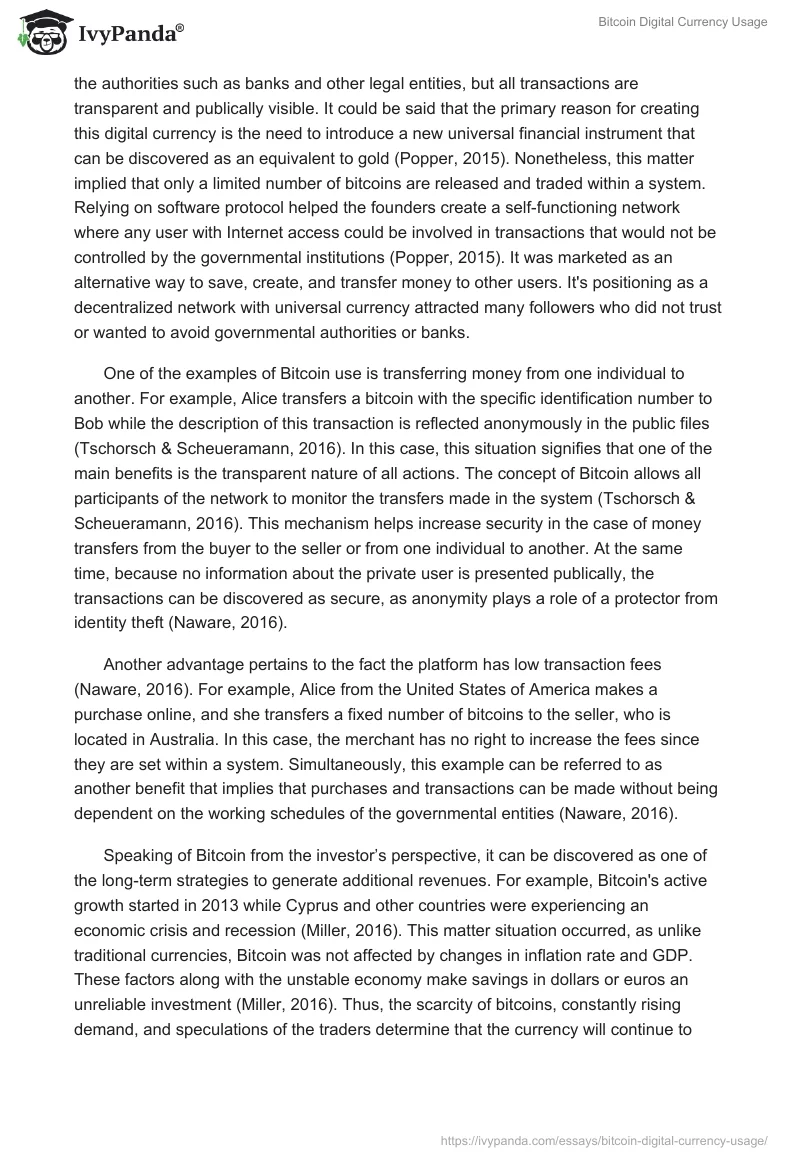Introduction
Living in the era of information technology implies that the majority of transactions are digitalized. These changes have influenced many spheres, and it could be said that they were the primary drivers for the development of various types of digital currencies (Chuen, 2015). These categories of money can be actively used to purchase different goods and services online while being considered as reliable financial instruments. Bitcoin is one of the well-known currencies, and it has worldwide recognition. It is the central player in the market of the digital currencies and can be considered as one of the concepts that have an impact on the development of the modern e-commerce (Tschorsch & Scheueramann, 2016). Overall, it could be said that this trend is one of the main concepts of e-economy, and it shows that the financial world continues to evolve and takes advantage of various innovative financial principles and novelties (Chuen, 2015).
Speaking of the value of this topic to businesses, platforms like Bitcoin offer more opportunities to companies that operate in different industries. For example, they ease transactions by making money transfers fast and secure. At the same time, due to the rising popularity of digital currencies worldwide, the companies have to monitor any changes in demand for these financial tools and be prepared to modify their payment methods to stay competitive and be attractive to their customers. As for society, active involvement of the Internet in everyday activities implies that digital currencies such as Bitcoin may become more popular, as they ease the purchasing process. Overall, digital currencies are important to consider in the context of this case study since they have a critical impact on consumer behavior and the economic environment.
Case Study Analysis
As it was mentioned earlier, the central aim of this case study is to focus on digital currencies such as Bitcoin. The concept of Bitcoin was developed in 2009 by Nakamoto, who introduced the idea of the decentralized currency (Tschorsch & Scheueramann, 2016). This idea implies that the issue of bitcoins is not controlled by the authorities such as banks and other legal entities, but all transactions are transparent and publically visible. It could be said that the primary reason for creating this digital currency is the need to introduce a new universal financial instrument that can be discovered as an equivalent to gold (Popper, 2015). Nonetheless, this matter implied that only a limited number of bitcoins are released and traded within a system. Relying on software protocol helped the founders create a self-functioning network where any user with Internet access could be involved in transactions that would not be controlled by the governmental institutions (Popper, 2015). It was marketed as an alternative way to save, create, and transfer money to other users. It’s positioning as a decentralized network with universal currency attracted many followers who did not trust or wanted to avoid governmental authorities or banks.
One of the examples of Bitcoin use is transferring money from one individual to another. For example, Alice transfers a bitcoin with the specific identification number to Bob while the description of this transaction is reflected anonymously in the public files (Tschorsch & Scheueramann, 2016). In this case, this situation signifies that one of the main benefits is the transparent nature of all actions. The concept of Bitcoin allows all participants of the network to monitor the transfers made in the system (Tschorsch & Scheueramann, 2016). This mechanism helps increase security in the case of money transfers from the buyer to the seller or from one individual to another. At the same time, because no information about the private user is presented publically, the transactions can be discovered as secure, as anonymity plays a role of a protector from identity theft (Naware, 2016).
Another advantage pertains to the fact the platform has low transaction fees (Naware, 2016). For example, Alice from the United States of America makes a purchase online, and she transfers a fixed number of bitcoins to the seller, who is located in Australia. In this case, the merchant has no right to increase the fees since they are set within a system. Simultaneously, this example can be referred to as another benefit that implies that purchases and transactions can be made without being dependent on the working schedules of the governmental entities (Naware, 2016).
Speaking of Bitcoin from the investor’s perspective, it can be discovered as one of the long-term strategies to generate additional revenues. For example, Bitcoin’s active growth started in 2013 while Cyprus and other countries were experiencing an economic crisis and recession (Miller, 2016). This matter situation occurred, as unlike traditional currencies, Bitcoin was not affected by changes in inflation rate and GDP. These factors along with the unstable economy make savings in dollars or euros an unreliable investment (Miller, 2016). Thus, the scarcity of bitcoins, constantly rising demand, and speculations of the traders determine that the currency will continue to increase in a geometrical progression. Nonetheless, Bitcoin hurts economic growth, as the governments of different countries cannot control the amount and value of bitcoins.
Nonetheless, apart from the benefits mentioned above, many disadvantages tend to exist. The most common threats are related to the potential price volatility due to a limited number of bitcoins, lack of recognition, and possible issues with encryptions and protocols (Naware, 2016). Additionally, many drawbacks are associated with the anonymous nature of transactions and the absence of a centralized controlled system. For example, in 2016, the Bitcoin platform was used to finance and fund a group of terrorists in Indonesia from the Islamic State (Yumar, 2017). The investors highly relied on digital currencies, as their concepts of anonymity and rapid delivery of financial resources made it difficult to track these money transfers (Yumar, 2017). Alternatively, this currency was used not only to support terrorism but also to sell and buy drugs and weapons. The Silk Road is one of the examples, as it was a website that actively used bitcoins as a trading currency to exchange them for drugs (Maftei, 2015). This side of Bitcoin supports the growth of crime levels related to drug trafficking and gambling while making it a serious social issue.
Conclusion
Based on the analysis conducted above, it could be said that Bitcoin can be considered as the future of the global economy, and it will become a pivotal player in the exchange market. This situation may incur, as Bitcoin’s value continues to increase due to low volatility and responsiveness to various political and economic factors, its scarcity, and the rising popularity of e-commerce worldwide. At the same time, its major benefits that attract the audience are associated with the transparency of transactions, their anonymity, fast transfers, and low fees. A combination of these factors signifies that concepts such as Bitcoin will revolutionize the principles of consumer behavior and e-commerce. Nonetheless, apart from the positive features, many examples show that the advantages of Bitcoin are used for illegal purposes to sell drugs and finance terrorism. These mattes imply that the working mechanism of Bitcoin has to be enhanced to avoid legal problems and decrease a negative impact on society.
References
Chuen, D. (2015). Handbook of digital currency: Bitcoin, innovation, financial instruments, and big data. London, UK: Academic Press.
Maftei, L. (2015). Bitcoin – Between legal and informal. CES Working Papers, 6(3), 53-59.
Miller, M. (2016). The ultimate guide to Bitcoin. Indianapolis, IN: Pearson Education.
Naware, A. (2016). Bitcoins, its advantages, and security threats. International Journal of Advanced Research in Computer Engineering & Technology, 5(6), 1732-1735.
Popper, N. (2015). Digital gold: The untold story of bitcoin. London, UK: Penguin Books.
Tschorsch, F., & Scheueramann, B. (2016). Bitcoin and beyond: A technical survey on decentralized digital currencies. IEEE Communications Surveys & Tutorials, 18(1), 1-37.
Yumar, R. (2017). Bitcoin, PayPal used to finance terrorism, Indonesian agency says.The Wall Street Journal. Web.


